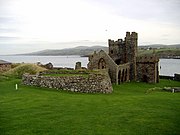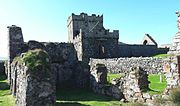inscribed and dated "Peel Castle Isle of Man September 1873" and signed with initials "LWT"
Tom and Laura Taylor and thence by descent
Peel Castle is a castle in Peel on the Isle of Man, originally constructed by Norwegians. The castle stands on St Patrick's Isle which is connected to the town by a causeway. It is now owned by Manx National Heritage and is open to visitors during the summer.
The castle was built in the 11th century by Norwegians, under the rule of King Magnus Barefoot. While there were older stone Celtic monastic buildings on the island, the first Norwegian fortifications were built of wood. The prominent round tower was originally part of the Celtic monastery, but had battlements added at a later date. In the early 14th century, the majority of the walls and towers were built primarily from local red sandstone, which is found abundantly in the area. After the rule of Norway, the castle continued to be used by the Church due to the cathedral built there – the see of the diocese of Sodor and Man – but was eventually abandoned in the 18th century.
The castle remained fortified, and new defensive positions were added as late as 1860. The buildings within the castle are now mostly ruined, but the outer walls remain intact. Excavations in 1982-87 revealed an extensive graveyard as well as the remains of Magnus Barefoot's original wooden fort. The most spectacular finds were the 10th century grave of "The Pagan Lady" which included a fine example of a Norwegian necklace and a cache of silver coins dating from about 1030. The Castle's most famous "resident" is the so-called Moddey Dhoo or "Black Dog" ghost.
Peel Castle features today on the reverse side of the banknotes of the Manx Pound £10 notes issued by the Isle of Man Government.
Peel Castle may occasionally be confused with Piel Castle, located on Piel Island, to the east across the Irish Sea. This particularly occurs in reference to the William Wordsworth poem describing Piel, spelling its name as 'Peele': especially as Wordsworth is documented as having visited Peel Castle, and wrote several times about the Isle of Man.
Peel Castle has been proposed as a possible location of the Arthurian Avalon.

The cathedral ruins located within the walls of Peel Castle are those of the former Cathedral of St German. Like the structures throughout the castle grounds, the cathedral's roof is completely missing. Robert Anderson examined the ruins to determine what repairs were required to restore the cathedral, and he reported to the island's Lieutenant Governor in 1877. However, none of the suggested repairs were carried out.
There is a pointed barrel-vaulted crypt below the chancel, measuring 34 feet by 16 feet by 9 feet high at the west end (10 × 5 × 3 metres), sloping to the entrance at the east.
In the middle of the transept is the tomb where Bishop Rutter was interred in 1661.
There is a cemetery in what was once the cathedral's nave.
In 1980 the parish of German, part of the Church of England's Diocese of Sodor and Man, was officially transferred to the newer Cathedral Church of St German on Albany Road in Peel.
-
The cathedral, inside the castle
-
Chancel of the Cathedral of St. German
-
The Cathedral behind the late 15th century Lord's Apartments
-
The round tower, in the ruins of Peel Castle
-
The 10th or 11th century round tower viewed through the window of St. Patrick's Church
Laura Wilson Barker (6 March 1819 – 22 May 1905), was a composer, performer and artist, sometimes also referred to as Laura Barker, Laura W Taylor or "Mrs Tom Taylor".
She was born in Thirkleby, North Yorkshire, third daughter of a clergyman, the Rev. Thomas Barker. She studied privately with Cipriani Potter and became an accomplished pianist and violinist. As a young girl Barker performed with both Louis Spohr and Paganini. She began composing in the mid-1830s - her Seven Romances for voice and guitar were published in 1837. From around 1843 until 1855 she taught music at York School for the Blind. During this period some of her compositions - including a symphony in manuscript, on 19 April 1845 - were performed at York Choral Society concerts.
On 19 June 1855 she married the English dramatist, critic, biographer, public servant, and editor of Punch magazine Tom Taylor. Barker contributed music to at least one of her husband's plays, an overture and entr'acte to Joan of Arc (1871), and provided harmonisations as an appendix to his translation of Ballads and Songs of Brittany (1865).
Her other works include the cantata Enone (1850), the violin sonata A Country Walk (1860), theatre music for As You Like It, (April 1880), Songs of Youth (1884), string quartets, madrigals and solo songs. Her choral setting of Keats's A Prophecy, composed in 1850, was performed for the first time 49 years later at the Hovingham Festival in 1899. The composer was present.
Several of Barker's paintings hang at Smallhythe Place in Kent, Ellen Terry's house.
Barker lived with her husband and family at 84 Lavender Sweep, Battersea. There were two children: the artist John Wycliffe Taylor (1859–1925), and Laura Lucy Arnold Taylor (1863–1940). The Sunday musical soirees at the house attracted many well-known attendees, including Lewis Carroll, Charles Dickens, Henry Irving, Charles Reade, Alfred Tennyson, Ellen Terry and William Makepeace Thackeray.
Tom Taylor died suddenly at his home in 1880 at the age of 62. After his death, his widow retired to Porch House, Coleshill in Buckinghamshire, where she died on 22 May 1905, aged 86.






